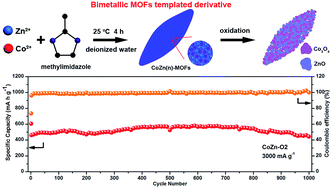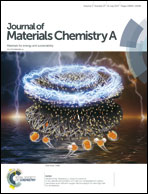Metal–organic framework-templated two-dimensional hybrid bimetallic metal oxides with enhanced lithium/sodium storage capability†
Abstract
Two-dimensional (2D) porous hybrid bimetallic transition metal oxide (TMO) nanosheets demonstrated promising applications in the energy field due to their large surface areas, porous structure, and synergistic effects. However, the synthesis of these materials is still a big challenge. In this study, we rationally designed a facile strategy to prepare 2D porous hybrid bimetallic TMO (Co3O4/ZnO) nanosheets with novel structural and electrochemical synergistic effects. Derived from bimetallic MOF nanosheets, the porous hybrid nanosheets possess high surface areas and large pore volume. In particular, they are rich in oxygen vacancies, which provide more active sites for electrochemical reaction. Moreover, the harmonious multi-step conversion reaction between Co3O4 and ZnO was helpful for volume buffering, leading to an outstanding cyclic stability. With remarkable structural features and harmonious electrochemical behaviors, the Co3O4/ZnO hybrids exhibit excellent electrochemical performances as anodes for both lithium-ion batteries (LIBs) and sodium-ion batteries (SIBs). This study also introduces a new strategy to prepare 2D porous hybrid bimetallic TMO nanosheets, which can find wide applications in energy storage, catalysis, sensors, and information storage devices.



 Please wait while we load your content...
Please wait while we load your content...